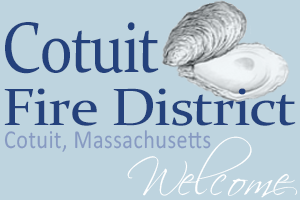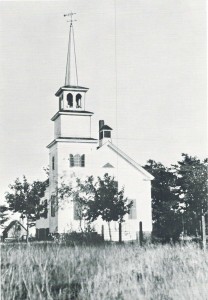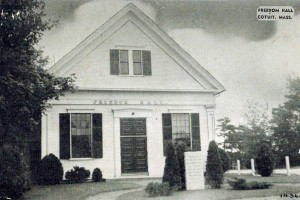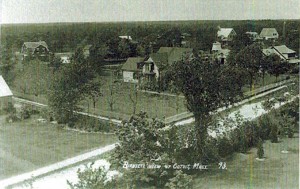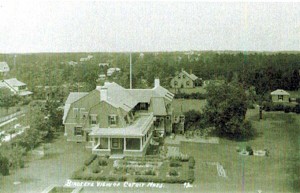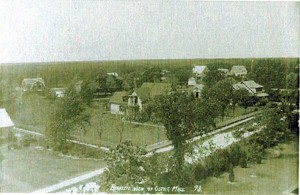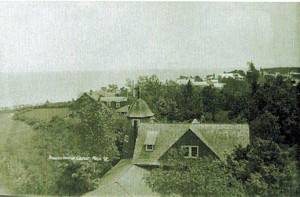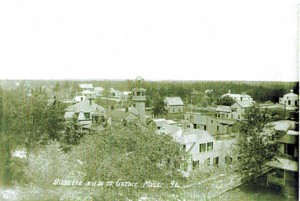Freedom Hall is the gathering place for the village of Cotuit. It was built by the citizens of the village in 1860 as a place for meetings, voting, and entertainment. We are fortunate to have a history of the hall courtesy of the Historical Society of Santuit and Cotuit.
Scroll down to the bottom of the page to read this and download a copy. There are two documents: one written in 1967 by Gordon M. Browne and one read at a meeting in 1968. Some great old photos, too,
Freedom Hall Event Calendar
Dates shown in dark numbers have events. Hover over the number to see the event. Use the Next and Back at the top edge of the calendar to scroll forwards and backwards for the months.
April 2024 |
||||||
|---|---|---|---|---|---|---|
| Sun | Mon | Tue | Wed | Thu | Fri | Sat |
|
1
|
2
|
3
|
4
|
5
|
6
|
|
|
7
|
8
|
9
|
10
|
11
|
12
|
13
|
|
14
|
15
|
16
|
17
|
18
|
19
|
20
|
|
21
|
22
|
23
|
24
|
25
|
26
|
27
|
|
28
|
29
|
30
|
||||
Would you like to schedule an event or get more information? Contact FreedomHall
FREEDOM HALL REGULATIONS AND CONTRACT
Freedom Hall is located at 976 Main Street in Cotuit, MA. Need directions? View a Google Map of Freedom Hall’s location.
Having trouble viewing the calendar on this page?
Click here to go directly to the Google Calendar page.
History of Freedom Hall
Courtesy: Historical Society of Santuit and Cotuit.
Written by: GORDON M. BROWNE, JR., July 14, 1967
The materials for this paper were carefully culled from the records of Freedom Hall by Mrs. Calvin Crawford and put together by Harriet Ropes Cabot, who takes most of the responsibility for errors.
Freedom Hall stands today, beside the old Union Church, now the Masonic Hall, on the height of land overlooking Cotuit Harbor, at a point between the “lower village” and Highgrounds. It is a long way to Santuit or Old Cotuit, but was a suitable central site in 1860, when it was built. It is a building familiar to all residents of Cotuit, both winter and summer, as a place for local meetings, entertainment and voting. By 1860, the south side villages of the Town of Barnstable had grown so that their close ties to the mother village of Barnstable were broken and from 1830 or 1840 local halls began to appear around the town. In Cotuit a need was felt, as it was set forth in the constitution, for a “suitable place for all well disposed persons to assemble in, hold meetings, lectures, assemblies, parties, lyceums, etc.” Therefore, on February 4, 1860, a meeting was called to “consider the expediency of building a public hall in this vicinity.” Charles C. Bearse was the moderator and Andrew Lovell, the clerk. Two committees were appointed, the first to draw up a constitution. The members were Ensign Nickerson, Samuel Nickerson and Andrew Lovell. The second committee was to select a lot for the building and consisted of Captains Seth Nickeson, Jr., James Coon and Charles C. Bears; The committees were quick and efficient and by February 28, 1860, it had been voted to acquire the land owned by Leander W. Nickerson beside the Union Meeting House, which had been built jointly by the Baptists, Methodists and Congregationalists in 1846. The treasurer of the stockholders of Freedom Hall, Charles C. Bearse, paid Captain Nickerson $100 for “a piece of cleared land in the Southwest part of said Barnstable” at Cotuit Port. (Book 74, page 478, Town of Barnstable). This lot ran from the Northeast corner of the Union Meeting House, west by the County Road (Main Street) to the land of Grafton Phinney, easterly to a stake and stones and back to the corner of the church. The remaining land, now owned by Fred Fricks, also belonged to Captain Nickerson and was later exchanged for another parcel with Sylvester Jones, whose family continued to live there until fairly recent times.
At the same meeting of February 28, shares were issued at $5 each and a Building Committee was formed to “fix the size of the hall and probable cost.” The members of this group were Charles C. Bearse, Samuel Nickerson and Seth Nickerson, Jr. The size of the hall was to be 33 by 40 feet and the cost was not to exceed $1400. It was further stipulated that “if the hall cannot be built for that sum, the building shall be reduced in size until the sum obtained will build it in a suitable and substantial manner.” The subscribers who bought the largest number of shares were Capt. Seth Nickerson, Jr. ($200), Capt. James Coon ($150), Capt. Charles C. Bearse ($125), and Jarvis Nickerson ($100). Two summer residents who were not sure of getting their money back and were also generous minded made outright gifts of $100 each. These were the congressman, and merchant, Samuel Hooper (great-grandfather of Mrs. Edward W. Moore) and James Parker, who lived in the house then next to Mrs. Moore’s, now owned by Dr. Keith Rapp. He was Mrs. A. Lawrence Lowell’s uncle.
Things moved efficiently and well and the building was ready for its first meeting by January 10, 1861. The hall was designed in the simplest Greek Revival style by its anonymous builders and architects. Cape Cod was slow to follow the fashions of the mainland, but it is appropriate that this building, called Freedom Hall in the habit of the time which linked the Revolutionary ideals of Freedom with the Abolition Movement to free the slaves, should have been built in a style symbolic of the classic ideas and philosophy of the period. The men who planned and erected it were sea captains and carpenters and storekeepers. They were familiar with the handsome Greek Revival houses built on Nantucket after 1846 as well as those in New Bedford and other ports. They were well-read, intelligent and independent. They were probably acquainted with the Builders Guides and other manuals for builders, though there is so little detail in the decoration of this building that these were probably not consulted. Cotuit is fortunate to have this little building rather than a more elaborate building which would have been erected after the Civil War.
The first meeting of the stockholders was held in the completed hall on January 10, 1861. John Linnell, James Coon and Seth Nickerson were chosen to be in charge of the hall and it was decided to auction off the job of maintenance, lighting, etc. yearly. This year the lowest bidder was Seth Nickerson at $25.75. Inevitably, the price increased quickly until it was $85 in 1885. The society was managed first by a secretary-treasurer, but in 1864 Charles C. Bearse was made moderator, a post he held for ten years. Already ill 1864 it was felt that the hall was not large enough, and a committee of P. A. Burlingame, Samuel Nickerson and Andrew Lovell discussed an addition. However, this was not achieved until 1882. Meanwhile the building was busy every winter with dancing school, singing school, balls, sewing circle fairs, exhibitions, and after 1874 by weekly Lyceums in the form of debates, lectures and other entertainment. These were popular and in 1867 alone, $279 was collected.
One can guess a little about the furnishings of Freedom Hall. It was heated by a large pot-bellied stove and kerosene lamps hung on the walls. Community organizations have always used the hall. In 1867 the Young Men’s Association were given room in the gallery for a bookcase and the Good Templars space for a chest. In February 1870, the Masons were allowed to finish and occupy rooms in the attic for a Lodge, at a cost of $467.89, and the next year the Good Templars were told that if they did not pay their bill the hall would be closed to them.
At every annual meeting shares were actively bought and sold by stockholders, and in 1874, 137 new shares were sold. This was the year when members wished to enlarge the hall and a feud developed between the old and new stockholders about the building. The enlargement was not voted until 1884. At that time 137 new shares were sold, numerous entertainments were presented to raise money, including a concert by Ryder’s Cornet Band. Gifts brought the total collected to $85 3. At the same time the Old Stock holders insisted to the New Stockholders that a larger hall was not needed. However, a section was added at this time. In 1886 the Library Association was allowed to lease land behind the hall where its building stood at $3 per year. Freedom Hall was surely the center of the village. In 1896 it was decided to build a stage in the hall, which was later graced by a gay painted curtain showing a view of Cotuit Harbor. In that year also, the Town of Barnstable was charged $10 for the use of the hall as a voting place. In 1899, A. E. Nickerson was in charge of enlarging the room under the main hall for a dining room and the next year a stairway was added outside for fire requirements. Modern improvements came as well as more groups. In 1902 the rent of the Mariners Lodge of Free Masons was raised to $25. They were required to allow the recently organized Lodge of the Knights of Pythias No. 145 of Cotuit, to hold their meetings in the Lodge room in the attic. In 1903 it was voted that when the committee had a sufficient sum of money beyond the ordinary running expenses that they should add a “heating apparatus” under the hall. Perhaps the days of 1876 had gone when the custodian, James A. Fish was empowered to “eject anyone who spit tobacco juice on the floor.”
The records of the stockholders of freedom Hall from 1903 to 1935 have disappeared. The hall was in great demand during this time for both private and public functions. From the turn of the century, Christmas parties were held yearly with a large community Christmas tree. Parents brought gifts to be given to their children by Santa Claus and a collection was taken up in the village to provide bags of candy, an orange and a game or book for each child present from Cotuit and Santuit. Home talent provided entertainment while waiting for Santa.
With the advent of the moving picture, Ernest 0. Dottridge ran weekly movies regularly with Mrs. Arnold Smalley at the piano. The interest was such that in order to start the movies on time it was arranged that whoever wished to receive their mail could leave his name at the Box Office. In the intermission, Mr. Seabury Childs, the constable delivered it to patrons. Your editor clearly remembers seeing Mary Pickford, Charlie Chaplain and other movie pioneers from a yellow bench in Freedom Hall. To us it was a very special excitement as we were not ordinarily allowed to go to movies, so that an invitation from friends or a prohibited secret expedition added great adventure. Again, Mr. Childs officiated in an attempt to control the particularly unruly summer children. With the coming of the talking pictures and the freer use of automobiles to get to Osterville or Hyannis, the movies left Cotuit and Freedom Hall forever.
By the time the Cotuit Fire District was organized in 1926, the shareholders of Freedom Hall were finding it difficult to continue to maintain the building which was beginning to deteriorate. Therefore in 1935, they voted to present the hall to the Fire District. The District contributed $3800 and with the help of a grant from the Works Progress Administration, repairs were started. Freedom Hall was rededicated on December 7, 1936 and a new era began. Many uses were found for the old building and increased with the coming of World War II. First Aid and Wardens instruction classes were held here. Engineers from the Amphibious Command at Camp Can Do-It in Little River used it as a reading room and en joyed the showers installed in the basement. A meeting of the General Alliance of the Unitarians was held here in 1943.
In 1939 the Town of Barnstable celebrated its Tercentenary. Freedom Hall was the center of the week of Cotuit celebrations. Peter Campbell was chairman and speakers were our Congressman, Hon. Charles L. Gifford and President A. Lawrence Lowell of Harvard University. Reginald F. Bolles designed a new seal for the Fire District which was unveiled by Madeline Harlow and William H. Perry, III. As was done in other villages, a granite monument “Dedicated to the men and women who in 1648 first settled in this area” was set up in front of the building and unveiled by Marion Dottridge. A fine loan exhibition of ship paintings, antiques and photographs of Cotuit was arranged. One evening a “Colonial Ball” was held featuring an intricate grand march led by Mrs. Joseph Swift of Vineyard Haven and William Perry, I, of Santuit. Fans with the dates 1639-1939 were distributed. The climax of the celebration was a band concert.
The hall is familiar ground for Boy Scouts, Cub Scouts, Girl Scouts and Brownies, Young Mothers’ Club, penny sales, auctions, the Santuit-Cotuit Historical Society, the Cotuit-Santuit Civic Association, the Cotuit Mosquito Yacht Club and last but” not least, its owner, the Cotuit Fire District. In 1968, the old building still seems to be carrying out ‘its original stated purpose as a place for “well-disposed persons to assemble in”. It is well kept up and its goods neighbors the Fred Fricks have generously planted the area around the hall to the delight of the community. The Historical Society has placed a plaque on the building stating that the date of its erection was in the year 1860.
FREEDOM HALL:
Read July 12, 1968
Courtesy: Historical Society of Santuit and Cotuit.
1935 was a busy year for the Cotuit Fire District. The first proposal for the new fire house was made that year, and the first planning for the Water Department was authorized. That year, too, the District voted to accept Freedom Hall and the property on which it stands as a gift from its shareholders. Freedom Hall had been built in 1860 by a group of shareholders and had been used as a gathering place for meetings, discussion groups, debates, and other civic purposes. Most District meetings had been held there, each one costing a $6 rental. Maintenance of the hall had become increasingly difficult for the shareholders, and the old building had begun to deteriorate. The idea of giving it to the District as a public hall may have originated with Calvin Crawford or with Seabury Childs- it is not clear which-but both seem to have helped the project along. Whether the District had a legal right to accept such a gift under its own enabling legislation is still subject to debate, but accept it it did.
Renovation work began almost immediately with the help of a WPA grant and $3,800 from the District. The Cotuit Civic Club, a church men’s club, gave the hall two gas stoves so that it could be used as a banquet hall; the American Legion gave the Hall “a fine silk flag”, and the voters approved the purchase of chairs for the meeting room. Later, how ever, when appropriations were requested to turn the Hall into a community center and to equip the banquet room with china and silver and utensils, the voters balked.
The uses to which Freedom Hall has been put have been varied indeed. In its report of 1941, the Prudential Committee noted, “Due to lack of a fireproof curtain on the stage the summer theatrical season which began so auspiciously came to a sudden end with the appearance of the State fire inspector.” The following year, the Committee reported, “Freedom Hall was used for First Aid classes and for Wardens’ instruction classes during the year. It was also used for a month by one of our amphibian engineer regiments for a reading room while the showers in the basement were in great demand until proper facilities were provided at Camp Candoit. The basement has been turned over to the Committee on Public Safety as a First Aid Station.” And the following year the Hall was used, among other things, for a five day conference of the “General Alliance of Unitarian and other Liberal Christian Women” with about 150 persons in attendance. Over the years since then the Hall has been used by a great variety of village groups, ranging from Boy Scouts to a Community Sing Group and a Young Mothers’ Club. There have been auctions, shows, penny sales, and exhibits. The Recreation Commission has run pro grams of all sorts there, including a basket ball league, a use which was the subject of considerable controversy. It is the official polling place of the District; it was the home of a Teen Club; it has alternately dozed and shaken through District meeting and Civic Association oratory. It deserves a separate paper of its own, and further discussion of it will be left for that future project of another writer.
The marker on the grounds in front of the Hall was placed there in 1939 as a part of the Tercentenary Celebration of the Town of Barnstable. The Parking lot is maintained by the Town on a lease from the District. In recent years the whole area outside the Hall has been beautified through the generosity of Mr. and Mrs. Fred Frick, who have provided the landscaping and plantings around the Hall at no cost to the District.
